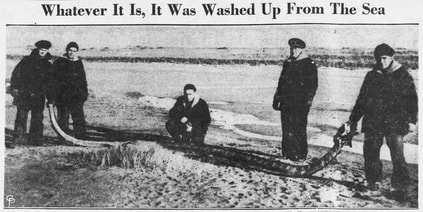 By M.P. Pellicer | Stranger Than Fiction Stories In 1939, reports came in that a sea serpent had washed up on Point Grey Beach in Vancouver. However sightings of these creatures off the North Atlantic coast go back more than a hundred years. 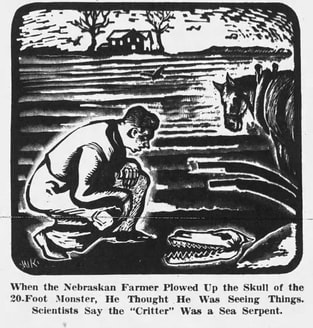 C.B. Campbell discovered an unknown species of marine reptile dating back to the Cretaceous period in his cornfield (Source - The Tennessean c.1939) C.B. Campbell discovered an unknown species of marine reptile dating back to the Cretaceous period in his cornfield (Source - The Tennessean c.1939) On January 14, 1939, Johnnie Davies was fishing on Williams Lake, British Columbia when he hooked something that not only pulled ferociously, but which he could see was a huge, dark shape beneath the ice. He tried to hold on but ended up letting go. According to him he thought it was the famed Ogopogo usually seen at Okanagan Lake. Fishermen in the area said he had probably hooked a land-locked sturgeon. It seems that January was a busy month for unusual finds. In the cornfields of C.B. Campbell, who lived near Lynch, Nebraska a dust storm exposed the fossil of a monster that later was dubbed a "sea serpent". It measured about 20-feet, and the marks of giant molar teeth on its bones and brain cavity, indicated it became a meal for a larger predator. Examination of the skeleton showed it was losing its gills and had two front claws or paddle wrist bones. It also had a blow-hole on top of the head, perhaps to inflate the head. Scientists opined it probably dated back to the Cretaceous period, but they couldn't agree what kind of sea monster had been found. They concluded that the "tail, bones and teeth belonged to three different orders of marine reptiles." The beast could swallow food whole, the same as a python, and the items found in the stomach included the tooth of a young shark, small fish vertebrae, stomach gravel, several scales of an unidentified sea animal and a number of vertebrae. It was initially named "Xenocephal", and some claimed it looked much like modern sightings of sea serpents. Campbell dug out 1,964 bones and 1,325 vertebrae. 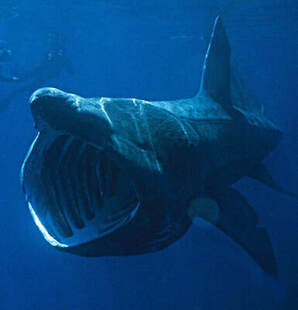 Basking shark Basking shark Then on January 18, 1939, it was reported that a 20-foot skeleton of a sea serpent had washed up near the Wood End coast guard station. The remains included vertebrae 8 inches in diameter, and four protuberances that appeared to be joints for legs or flippers. The skull was toothless. What little flesh was left on the bones was picked clean by the gulls. The commanding officer at the station said, "It couldn't have been a whale or a blackfish. The head must have been something like a crocodile's." The old timer's at Provincetown, Massachusetts recalled the sea serpent sighting of 1886. A fish expert, Dr. Remington Kellogg, said it was the backbone of a basking shark, claiming that when a shark decayed only the spinal column and part of the skull were left. This opinion was based after he examined the pictures only, not the remains itself. 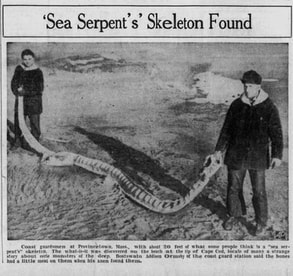 Skeleton of a supposed sea serpent that washed up on a shore in 1939 (Source - Intelligencer Journal) Skeleton of a supposed sea serpent that washed up on a shore in 1939 (Source - Intelligencer Journal) As far back as 1817, a sea serpent was sighted in the area around Gloucester Harbor in Cape Ann. It was described as having a head like a horse or a large dog. Its body was round like a snake's but connected by joints. It was estimated to be at least 40 feet long. Its motion was serpentine and it could swim rapidly despite its size. It was seen lying near the surface of the water. It would frequently leave a wake of half a mile in length. Then on August 23, 1817, it was seen off Kettle Island following and feasting on a large school of alewives. Two sharks appeared to follow it around, perhaps to eat the scraps it left behind. A few days later Capt. Beach claimed they had killed a small version of the sea serpent near Thatcher Island when it was making for the sea. It measured less than 4 feet and was only 3 inches in circumference. Whatever they killed, the sightings of what was referred to as the Gloucester Sea Serpent continued around Long Island Sound near Rye Neck. In May, 1818, it continued to haunt Cape Ann. In June, Shubael West, master of the packet Delia which plied between Kennebec River and Boston said he saw the sea serpent trying to best a large hump back whale. He appeared before one of the Justices of the Peace and made a solemn oath about the statement he provided on what he had observed. In August, $10,000 was being offered in Boston for the body of the sea serpent. Three expeditions were sent out comprised of "bold, hardy and capable adventurers", to cruise for the creature. They were armed with "harpoons, hooks, grapplers, rifles, muskets, swivels and seine." They were not successful and the sightings continued. In February, 1820, Captain Allyn of the ship Frances Henrietta said he saw the serpent off Long Island in 8 fathoms of water. He said, its "head looked like a grey rock, covered with moss; his back like an alligator; the tip of his tail was white; and he spouted water, apparently from three openings back of his head." He observed it for 45 minutes as it headed westward towards Sandy Hook. In September, a 12 foot shark was mistaken for the serpent and harpooned by a fisherman in a canoe hoping to capture a sturgeon on his line at the mouth of the Housatonac. Inside it they found a porpoise's head, a sheep's leg with the wool on it and an entire feathered hen. The skin was sold for $2, 8.5 gallons of oil were taken from the liver and the jaws were displayed at Capt. Porter's store, which showed 5 rows of ivory on each jaw, and could be drawn over a large man's shoulders. In October, 1824, the serpent was sighted by Philip Lefavour the skipper of a fishing boat heading to Marblehead. 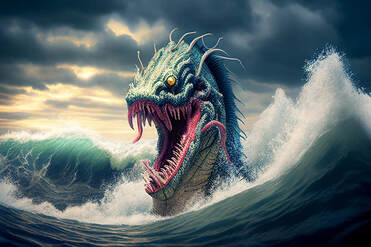 The Sea Serpent was seen along the North Atlantic coast for many years The Sea Serpent was seen along the North Atlantic coast for many years In 1830, Mr. Gooch of Kennebunk said he saw the creature. He said the "head was about the size of a 10 gallon cask and his eyes about the size of an ox." It was seen in Cape Cod, among the Islands in the Bay and at Nahant. Then a lighthouse keeper in Boothbay Harbor, Maine sighted it. In 1836, the sea serpent was now seen in the Mississippi River by the Mogul steamer bound from New Orleans to St. Louis. This was opposite the cliffs of Selmo. The Sea Serpent as it was known was reported through the years, usually by fishermen or captains of ships. Most considered it harmless, as it was seen hunting fish, but never attacking a ship or humans. The descriptions mostly coincided that it was serpentine-like, with coils that created a wake, and the head was similar to a horse or a large dog. Was this a real animal that stayed close to what were fishing ports along the North Atlantic, or was it just a story that some people wanted to bea part of?
0 Comments
Your comment will be posted after it is approved.
Leave a Reply. |
Stranger Than Fiction StoriesM.P. PellicerAuthor, Narrator and Producer Archives
July 2024
Categories
All
|
Stories of the Supernatural
- Stories of the Supernatural
- Miami Ghost Chronicles
- M.P. Pellicer | Author
- Stranger Than Fiction Stories
- Eerie News
- Supernatural Storytime
-
Astrology Today
- Tarot
- Horoscope
- Zodiac
-
Haunted Places
- Animal Hauntings
- Belleview Biltmore Hotel
- Bobby Mackey's Honky Tonk
- Brookdale Lodge
- Chacachacare Island
- Coral Castle
- Drayton Hall Plantation
- Jonathan Dickinson State Park
- Kreischer Mansion
- Miami Biltmore Hotel
- Miami Forgotten Properties
- Myrtles Plantation
- Pinewood Cemetery
- Rolling Hills Asylum
- St. Ann's Retreat
- Stranahan Cromartie House
- The Devil Tree
- Trans-Allegheny Lunatic Asylum
- West Virginia Penitentiary
- Paranormal Podcasts
"When misguided public opinion honors what is despicable and despises what is honorable, punishes virtue and rewards vice, encourages what is harmful and discourages what is useful, applauds falsehood and smothers truth under indifference or insult, a nation turns its back on progress and can be restored only by the terrible lessons of catastrophe."
- Frederic Bastiat
- Frederic Bastiat

Copyright © 2009-2024 Eleventh Hour LLC. All Rights Reserved ®
DISCLAIMER
DISCLAIMER
 RSS Feed
RSS Feed
















